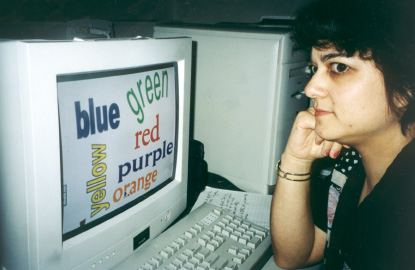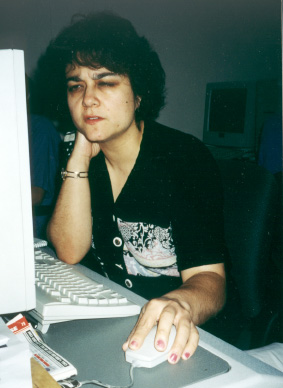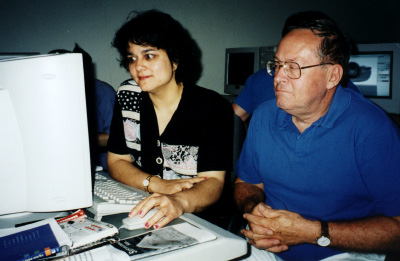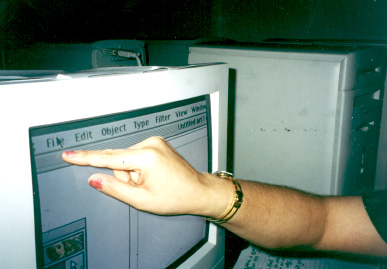 |
July 1999
|
| |
|
|
|
|
 |
July 1999
|
| |
|
|
|
|
|
|

By Mary Brady
integral-design@clark.net
What's black and white and read all over? Well, if it's also blue, yellow, green, purple and orange, it could be either a computer screen or "The Digital Page", a course which was offered this summer in the Continuing Studies Department of the renowned Maryland Institute of Art in Baltimore. And why do we fans of adaptive technology care? Eileen Rivera, MBA, National Sales Director for the Voice of the Diabetic, recently took a few weeks to explore that question rather thoroughly.
With the synergy of a receptive institution, a little (very little) adaptive technology, an accommodation in the form of a highly qualified aide recruited by Eileen and paid for by the school, a Vocational Rehabilitation counselor with the ability to think outside the box (or screen), and a strong sense of adventure, Eileen has learned several of the top graphic design software programs (Quark, Illustrator and Photoshop) and has made some interesting observations about graphic design and visually impaired audiences. She's also reflected a sentiment expressed in a recent article from the Society of Typographic Designers at Swindon College in the United Kingdom. (Design-for-All in Print: Student Design Project, pp 21-24, V ol 1, No. 1, 1999, eidd@tinet.ie). Namely, good design is design for the entire audience, not just the lowest common denominator.

Eileen's purpose in taking the course was "To learn to do graphic design in a way that's pleasing to visually impaired audiences". One of the results of this learning opportunity was to raise her confidence that she has a design sense. As a person with low vision, and a great deal of experience with large print documents which lacked any elements of good design, Eileen wasn't sure how well she could work with the Macintosh platform, software not designed for the visually impaired user, and the sighted instructor and other students unaccustomed to dealing with non-visual or low vision screen access issues. As it turned out, everything worked out beautifully!

The instructor, Melanie Rodgers,(mrodgers@gte.net) uses a graphic of an androgynous creature wearing thick glasses and playing with business-suited puppets as her business card, but don't let that throw you. She's hip to working with diversity in the classroom. She seemed genuinely delighted that Eileen had taught her how to audio describe visual elements of her instruction, much of which necessarily takes place on the video projection screen. Ms. Rodgers got a big assist from Pam Wheeler, the Art Insitute's "techie", who provided CloseView on the large display Macintosh set-up to accommodate Eileen's need for large print onscreen. Eileen's statement, "I never thought I would like a Mac!" was proof that this approach was successful.

The aide, Mr. Marty Hylbom, is a graphic designer in his own right, with a wealth of experience in newsletter design and production. Having met Eileen socially, he came to the experience of classroom vision specialist fresh but enthusiastic. Free of experiential prejudice, relaxed and brimming with well-formed questions would seem to capture the essence of his contributions to the effort.
The student, Eileen Rivera, is a graduate of both the Wharton and Harvard Business Schools who never stops learning. Not satisfied with the quality of large print documents she gets through the Library of Congress and other commercial sources, she decided to investigate the nature of graphic design for herself. What has resulted is The Clear View Review, a compendium of her findings and experience that should help all designers and businesses wishing to reach their entire market, which includes lots of folks with vision impairments. According to the previously cited study, six out of ten visually impaired persons consider themselves print users. That's a large and growing market, with our aging global population. And, as we know, the worlds of media, education and communication are becoming ever more graphic.

For more information about The Clear View Review, TT readers can contact Eileen Rivera at eileen@blazie.com.
For more information about the Continuing Studies Department of the Maryland Art Institute, try www.mica.edu/cs/cs_main.html
Home
Newsletter
Calendar
Previous
Index
Next
Contact